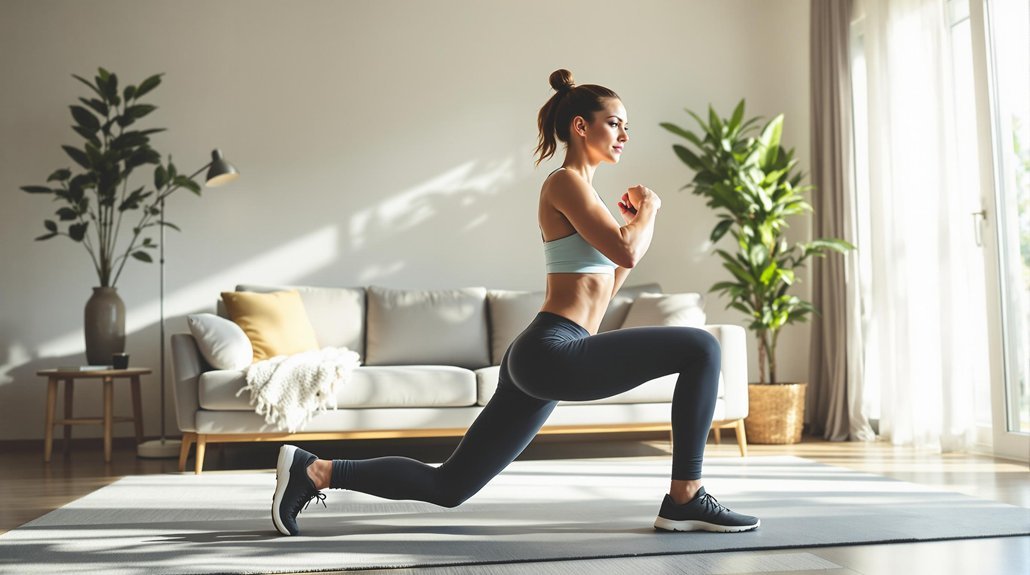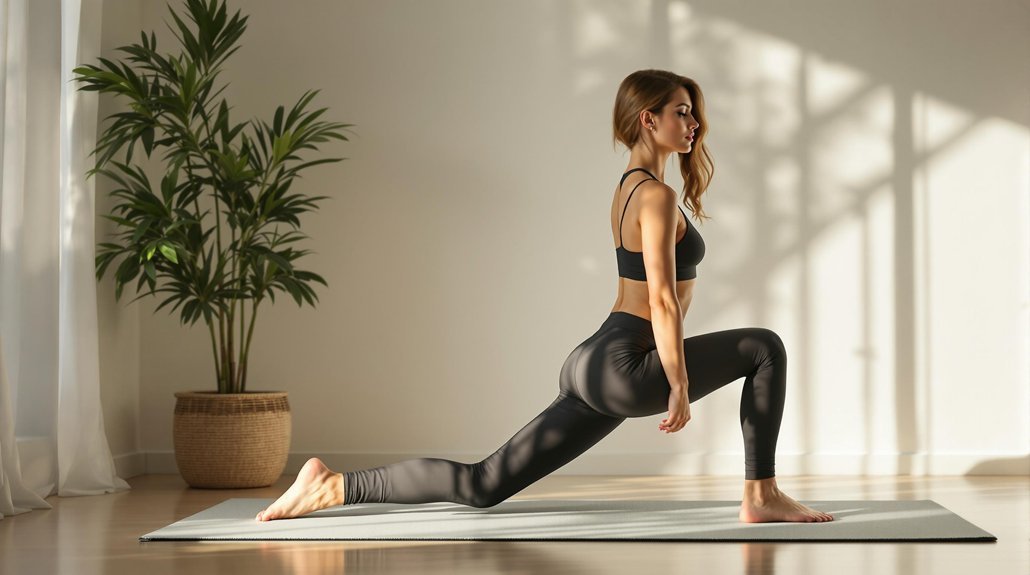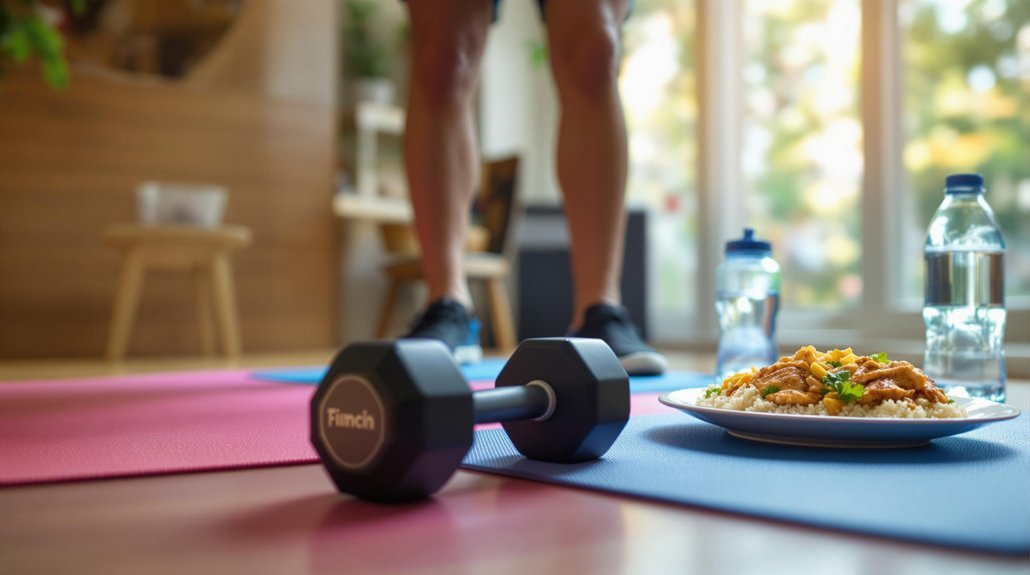For maximum results in home workouts, we focus on foundational strength training exercises that don't require gym equipment, such as squats, push-ups, and lunges, which are effective for building muscle and strength. These exercises can be modified for beginners, like knee push-ups, to guarantee progressive overload and enhance endurance. By incorporating core exercises and gradually increasing intensity, we maximize results and prevent injuries. Incorporating these exercises into a well-structured circuit with appropriate rest periods and consistent training sessions sets the stage for continuous improvement. As we explore further, understanding workout frequency, nutrition guidelines, and tracking progress becomes vital for achieving and sustaining success.
Key Takeaways
- Foundational Exercises: Focus on squats, push-ups, and lunges for effective strength training at home.
- Progressive Overload: Increase repetitions or intensity to achieve progressive overload and build muscle mass.
- Workout Circuit Design: Aim for 2-3 rounds of each circuit with 10-15 reps per exercise, resting 30-60 seconds between exercises.
- Proper Form and Consistency: Ensure proper form and maintain consistency with 2-4 sessions per week for muscle retention.
- Nutritional Balance: Combine workouts with adequate protein intake (1.2 to 2.2 grams/kg body weight daily) and a caloric surplus (250 to 500 calories) for muscle growth.
Picking the Right Exercises for Home Workouts

When we're designing a home workout routine, selecting the right exercises is essential for achieving thorough fitness results.
For beginners, bodyweight workouts are an excellent choice because they allow us to build strength and muscle without the need for equipment. Squats, push-ups, and lunges are foundational strength training exercises that target multiple muscle groups, including the upper body, lower body, and core.
To guarantee progressive overload, we can modify these exercises to suit our fitness level, such as using knee push-ups before progressing to standard push-ups.
By incorporating core exercises and structuring our workouts into circuit workouts, we can maintain continuous movement, enhance endurance, and build overall fitness.
Prioritizing proper form and gradually increasing repetitions or intensity is key to maximizing results and preventing injuries.
Building Strength With Bodyweight Exercises
Building strength with bodyweight exercises isn't only possible but also highly effective, especially for beginners who may not have access to a gym or prefer the convenience of working out at home.
Through a combination of squats, push-ups, lunges, and other exercises, we can effectively build muscle mass and strength without equipment.
The Key to Success lies in progressive overload, achieved by increasing repetitions, decreasing rest periods, or performing more advanced variations of exercises.
To maximize gains, consistency is essential, with 2-4 sessions per week recommended to support muscle retention and fat loss when paired with proper nutrition.
Techniques like increasing time under tension by slowing movements can enhance effectiveness, ensuring a balanced strength development by targeting a variety of muscle groups.
Designing Effective Workout Circuits

To maximize results, aim for 2-3 rounds of each circuit, with 10-15 reps per exercise and 30-60 seconds of rest between exercises.
Monitoring your progress by tracking reps, sets, and workout frequency is key. As your strength and endurance improve, adjust the intensity or add variations to keep your at-home workouts challenging and effective.
Workout Frequency and Rest Periods
| Training Level | Workout Frequency | Rest Periods |
|---|---|---|
| Beginner | 2-3 days/week | 48 hours |
| Intermediate | 3-4 days/week | 48 hours |
| Advanced | 4-5 days/week | 48 hours |
| All Levels | Varies by goal | 30 seconds – 5 minutes |
Gradually increasing training frequency can lead to greater muscle mass gains and improved endurance over time. Balancing workout frequency with adequate rest periods guarantees peak muscle recovery and overall fitness results.
Dynamic Warm-Ups and Cool Downs

- Key Elements of Dynamic Warm-Ups and Cool Downs:
- Dynamic Warm-Ups: Last 5-10 minutes, focusing on exercises that mimic the workout, such as jogging or jumping jacks.
- Injury Prevention: Proper warm-ups can prevent injuries by increasing muscle temperature and flexibility.
- Cool Downs: Include stretching to promote recovery by gradually lowering heart rate and reducing muscle soreness.
- Better Fitness Results: Incorporating warm-ups and cool-downs aids in muscle recovery and contributes to overall fitness results.
Progressive Overload Techniques
We can increase the number of repetitions, add more sets, or reduce rest time between exercises.
Advanced variations of exercises, such as moving from knee push-ups to standard push-ups, also serve as a method of progressive overload.
For bodyweight exercises, slowing down movements to increase time under tension is an effective strategy for enhancing muscle engagement.
Keeping a workout log to track improvements in performance, such as reps completed or exercise variations attempted, helps us maintain focus on progressive overload and build strength effectively.
Nutrition Guidelines for Muscle Growth

- Protein intake: Aim for approximately 1.2 to 2.2 grams of protein per kilogram of body weight daily to support muscle growth.
- Caloric surplus: Consume an additional 250 to 500 calories per day to create a caloric surplus, which is essential for gaining muscle mass.
- Nutrient-dense foods: Incorporate lean meats, fish, dairy, legumes, and whole grains to provide the necessary macronutrients and micronutrients for muscle recovery and growth.
- Post-workout nutrition and hydration: Consume protein-rich meals or snacks within 30 minutes to 2 hours post-workout.
Aim for at least 3 liters of water daily to enhance muscle protein synthesis and recovery.
Customizing Home Workouts for All Fitness Levels
| Bodyweight Exercises | Low-Impact Variations |
|---|---|
| Squats | Knee Push-Ups |
| Push-Ups | Wall Sit |
| Lunges | Step-Ups |
| Planks | Knee Planks |
Tracking Progress and Staying Motivated
As you commence your fitness journey, tracking your progress becomes an indispensable tool for staying motivated and achieving your goals. By consistently recording our workouts using a beginner bodyweight tracking sheet, we can monitor improvements in reps, sets, and overall performance over time.
Setting specific, measurable goals for each workout helps us stay focused and motivated to achieve incremental progress.
Key strategies for tracking progress and staying motivated include:
- Regular Tracking: Recording workouts and nutrition to highlight patterns and areas for improvement.
- Measurable Goals: Setting specific, achievable objectives to guide each workout.
- Community Support: Engaging with communities like the Nerd Fitness Rebellion for encouragement and accountability.
- Review Achievements: Celebrating small and large victories to boost confidence and reinforce commitment to our fitness routine.
Advanced Home Workout Variations**
Once you have mastered the basics of home workouts, incorporating advanced variations can help you break through plateaus and achieve greater strength gains.
Advanced home workout variations, such as one-legged squats and elevated pike pushups, increase the challenge and engage multiple muscle groups, leading to considerable strength gains.
Incorporating plyometric movements like jumping lunges and kneeling squat jumps enhances cardiovascular fitness and explosive strength while intensifying workouts.
To progress, it's vital to maintain proper form while gradually increasing repetitions, sets, or resistance to guarantee continuous muscle adaptation.
Using circuit training with minimal rest between exercises maximizes workout efficiency.
Additionally, exercises like planks with alternating leg lifts and advanced bird dog variations notably enhance core stability and coordination, essential for functional fitness.
In Closing
Unlocking Maximum Results at Home
We've shattered the myth that effective workouts require a gym membership. With the right bodyweight exercises, carefully crafted circuits, and consistent practice, you can transform your body and reach your fitness goals from the comfort of your own home. Design a routine that challenges you, learns to track your progress, and molds your workout to suit your fitness level. Ultimately, the power to achieve remarkable physical changes is literally in your hands.
